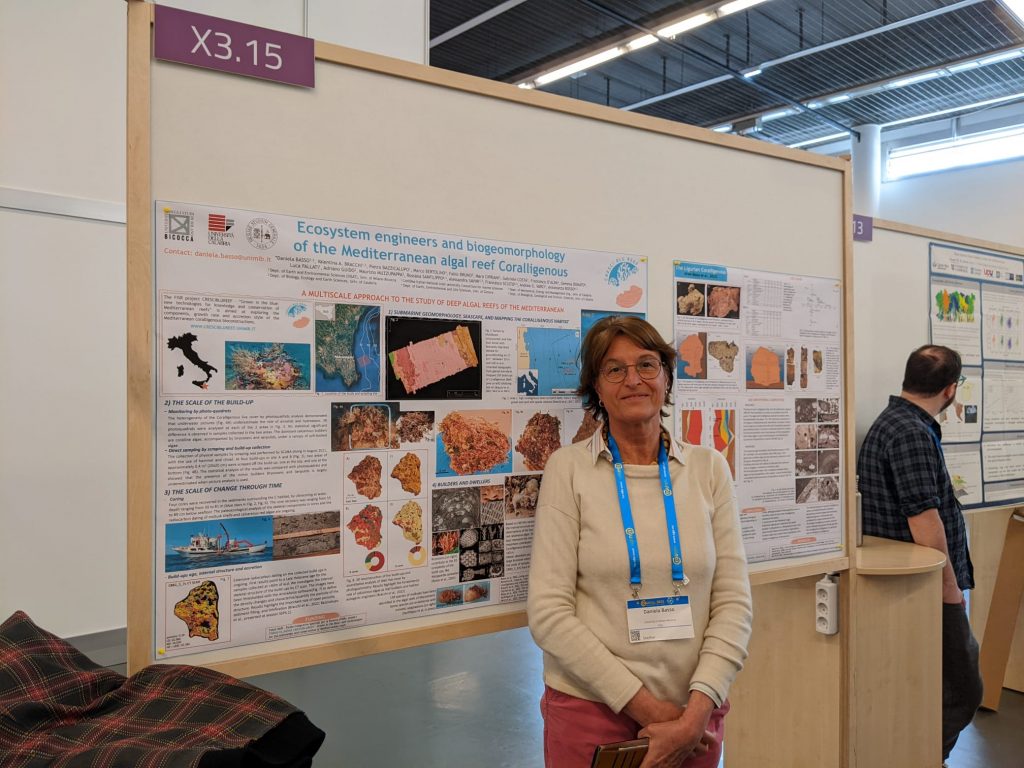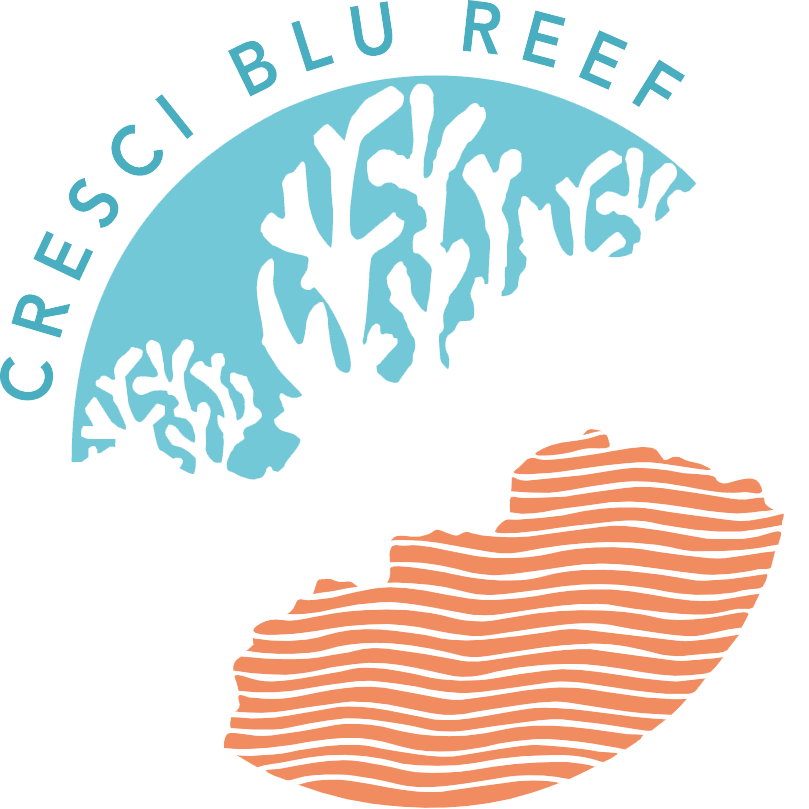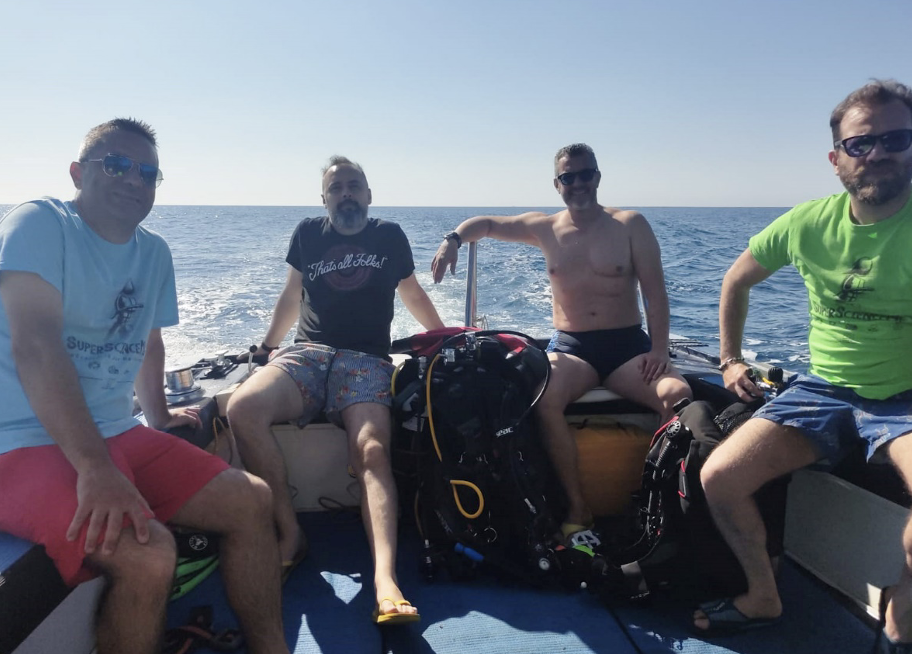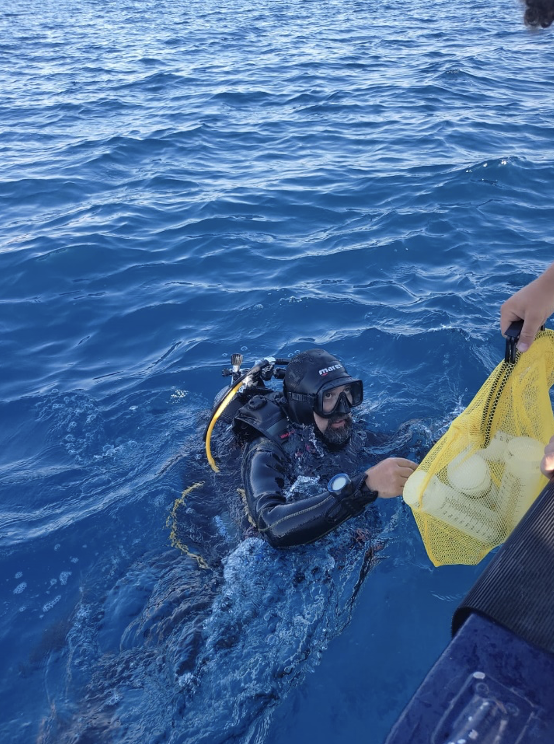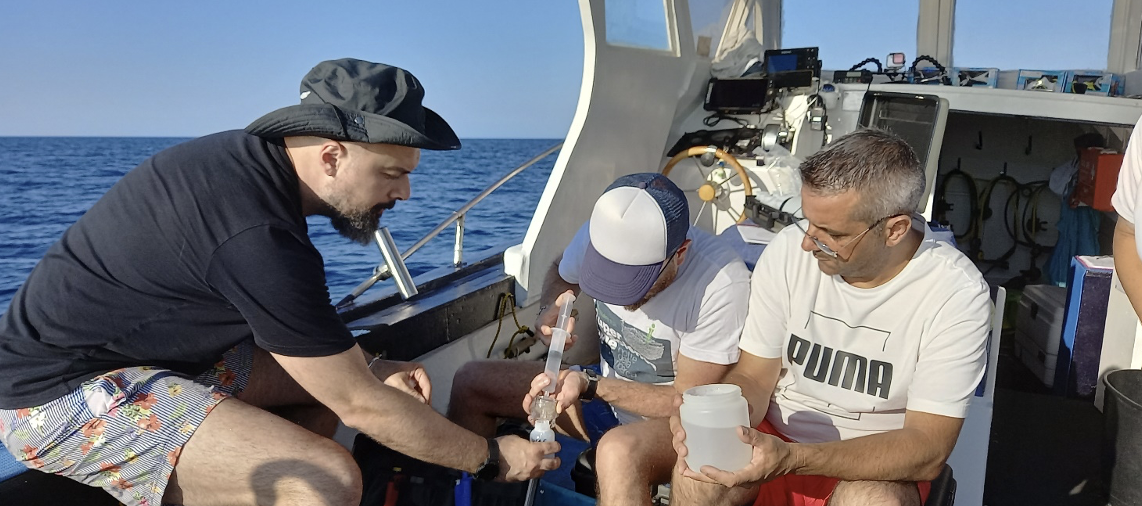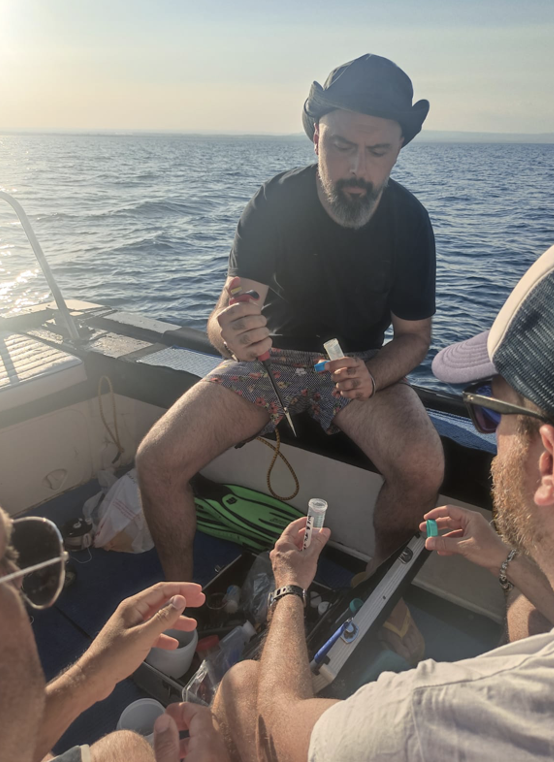Andate a leggere questo nuovo articolo su come nasce una ricerca… il racconto di Valentina Alice Bracchi: https://bnews.unimib.it/blog/diario-di-bordo-di-una-ricercatrice-alla-scoperta-della-geobiodiversità-marina/
Senza categoria
NEW PUBBLICATION “Mesophotic foraminiferal-algal nodules play a role in the Red Sea carbonate budget”
!! NEW SCIENTIFIC PAPER on #NatureCommunicationsEarth&Environment by Valentina Alice Bracchi!!
“Mesophotic foraminiferal-algal nodules play a role in the Red Sea carbonate budget”
This research explores for the first time the mesophotic foraminiferal-alagl nodule bed along the NEOM coast (Saudi Arabia), providing quantitative results on biogenic carbonate distribution – the habitat suitability model informs that more than 6 km2 are occupied by nodules – and production, accumulating more than 980 Megatons of biogenic carbonate at seafloor since tha last 2000 kyrs.
Link: https://www.nature.com/articles/s43247-023-00944-w
Keywords: Red Sea, NEOM, mesophotic, foraminiferal algal nodules, habitat suitability model, carbonate production
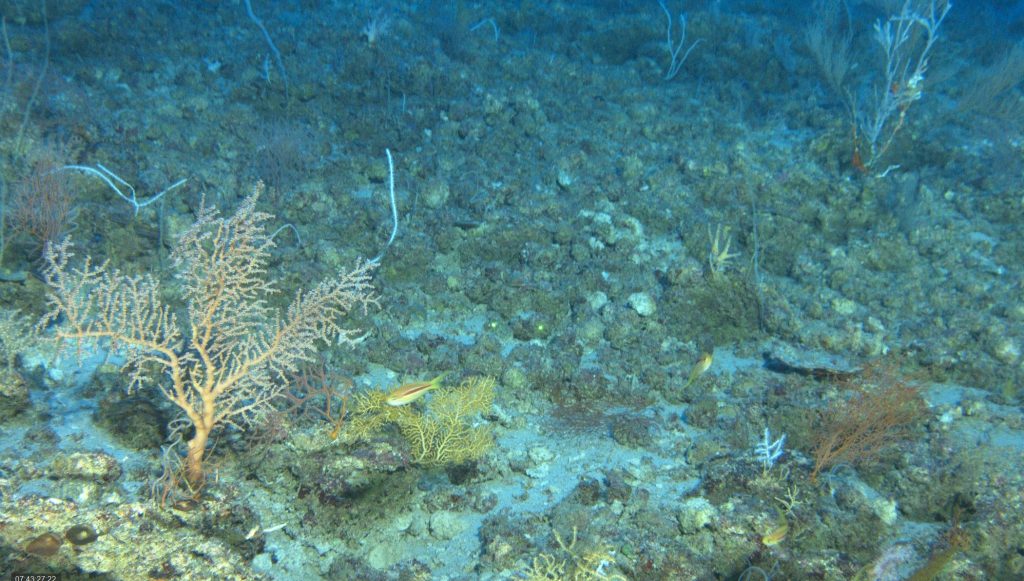
!! NUOVO ARTICOLO SCIENTIFICO su #NaturaComunicazioniTerra&Ambiente di Valentina Alice Bracchi!!
Questa ricerca esplora per la prima volta il letto di noduli mesofotici foraminiferi-alagli lungo la costa di NEOM (Arabia Saudita), fornendo risultati quantitativi sulla distribuzione del carbonato biogenico – il modello di idoneità dell’habitat informa che più di 6 km2 sono occupati da noduli – e sulla produzione, accumulando più di 980 megatoni di carbonato biogenico sul fondo del mare dagli ultimi 2000 mila.
Underwater core sampler field test!
MARZAMEMI 24-29 JULY 2023
Last July (24-29/07), on the seabed of Marzamemi (SR), the first test campaign of the remote-controlled vehicle for coralligenous sampling was carried out. The team has developed the device starting from data collected during previous tests on a semi-automatically operated system. During these operations, several issues emerged indeed, in particular regarding motor power as well as excessive weight and dimensions. Furthermore, the cores taken were mostly fragmented or completely damaged.
The result of the last year of design and development is a new remotely operated coring devices nearly 50% lighter than the previous one, having almost twice its coring torque. Geometry optimization and material selection resulted in a significant smaller prototype, suitable to be integrated underneath the ROV belly. Core tubes where also modified with an innovative “double tube” mechanism that enable to prevent core breakage or loss.
The new test campaign, carried out at depth from 25 to 35 meters, was preceded by preliminary tests in pool. Test were useful to verify the functioning of all the mechanical parts and to adjust ROV balancing. The first objective of the field tests was the identification of the target together with the descent and anchoring operations to the seafloor. Subsequently, the ability to carry out core drilling was verified, managing to sample the first core. The last goal was the activation of the tool change device thanks to which it was possible to carry out three core sampling during the same mission.
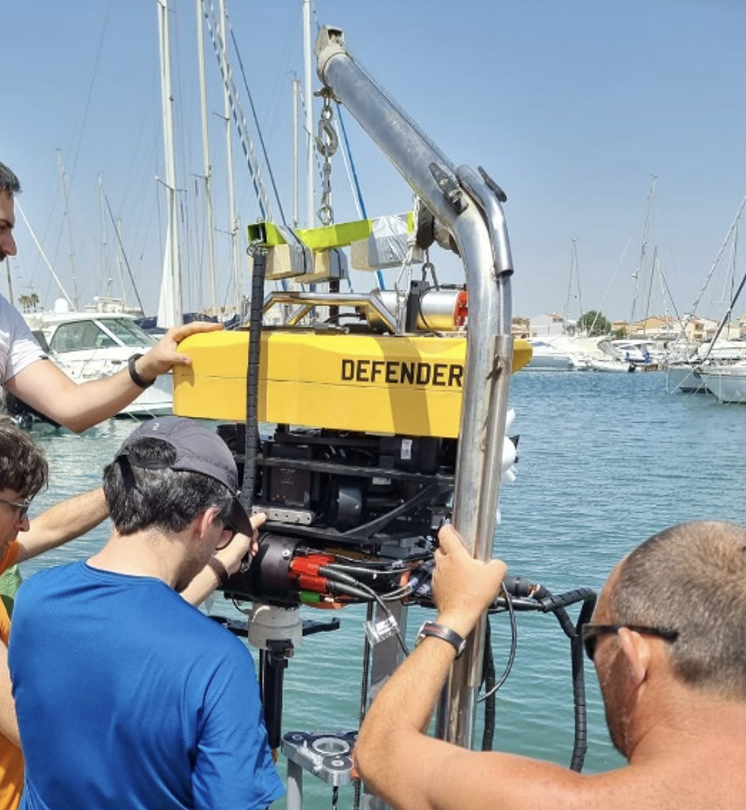
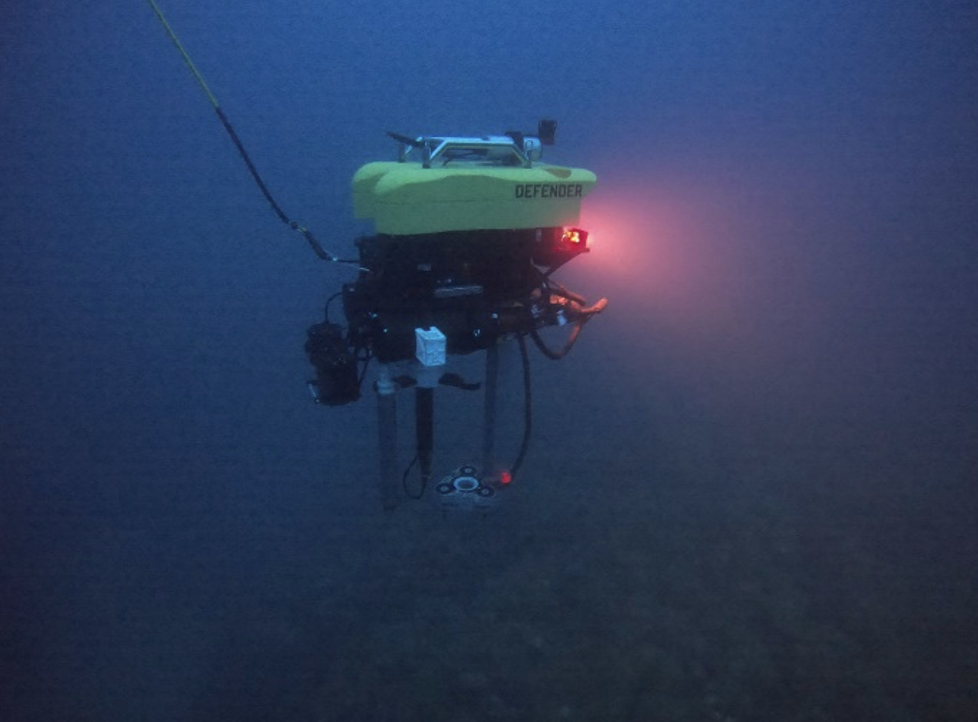
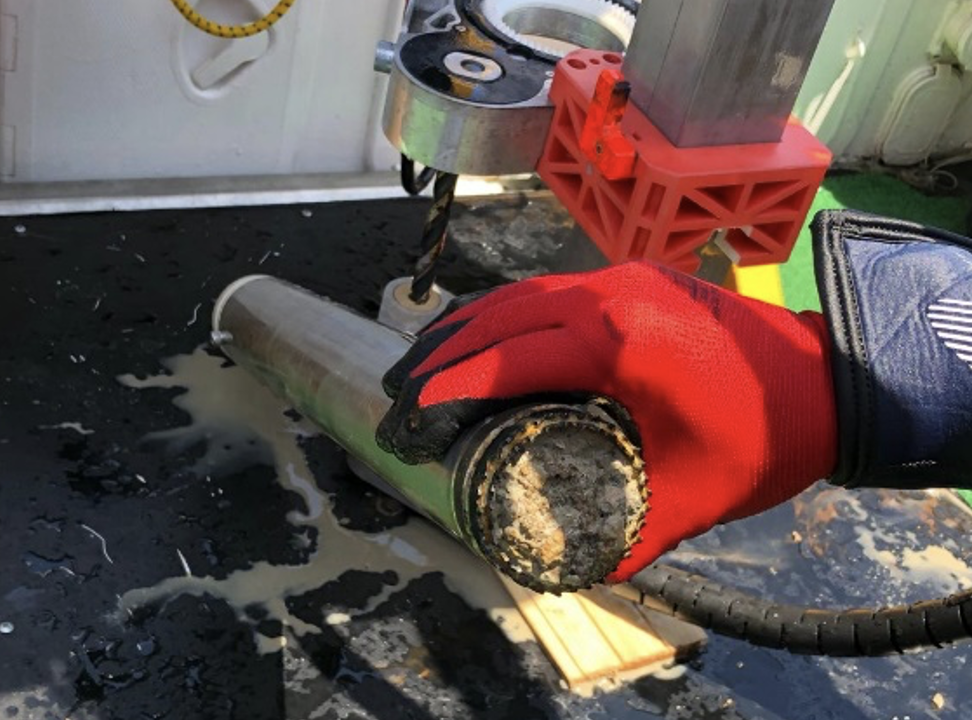
_ SIBM Messina 2023 _
Si è svolto a Messina il 52° Congresso della Società Italiana di Biologia Marina (SIBM). E’ stato organizzato dall’Università di Messina dal 12 al 15 giugno scorsi. Durante il congresso sono stati discussi argomenti interessanti con importanti miglioramenti nel campo della Biologia Marina.
Alcuni membri del team durante l’evento hanno presentato i lavori svolti nell’ambito del progetto FISR2019_04543 “CRESCIBLUREEF – Cresciuto nel blu: nuove tecnologie per la conoscenza e la conservazione dei reefs del Mediterraneo”.
Gemma Donato ha portato il poster del suo lavoro dal titolo “Strategie competitive su biocostruzioni coralline dello Ionio Meridionale”. Durante questo lavoro si sono focalizzati sulle strategie attuate da alcuni organismi costituenti il Coralligeno nello Ionio Meridionale. Sono stati investigati modo di vita e interazioni di alcune specie presenti in campioni prelevati nell’Agosto 2021, per grattaggio di biocostruzioni colonnari tra 33 e 36 metri al largo di Marzamemi (Sicilia).
Era presente ed ha partecipato fisicamente anche la professoressa Antonietta Rosso insieme al Dott. Marco Bertolino e la sua collega.
Il poster da loro presentato riguardava il seguente studio: “Bertolino M., Costa G., Bandi A., Basso D., Bazzicalupo P., Bracchi V.A., Cipriani M., Donato G., Guido A., Penco A., Rosso A., Sanfilippo R., Sciuto F., Bavestrello G. 2023. Variazioni a scala millenaria della diversità e abbondanza dei poriferi nel Coralligeno di Marzamemi (Sicilia SE).”
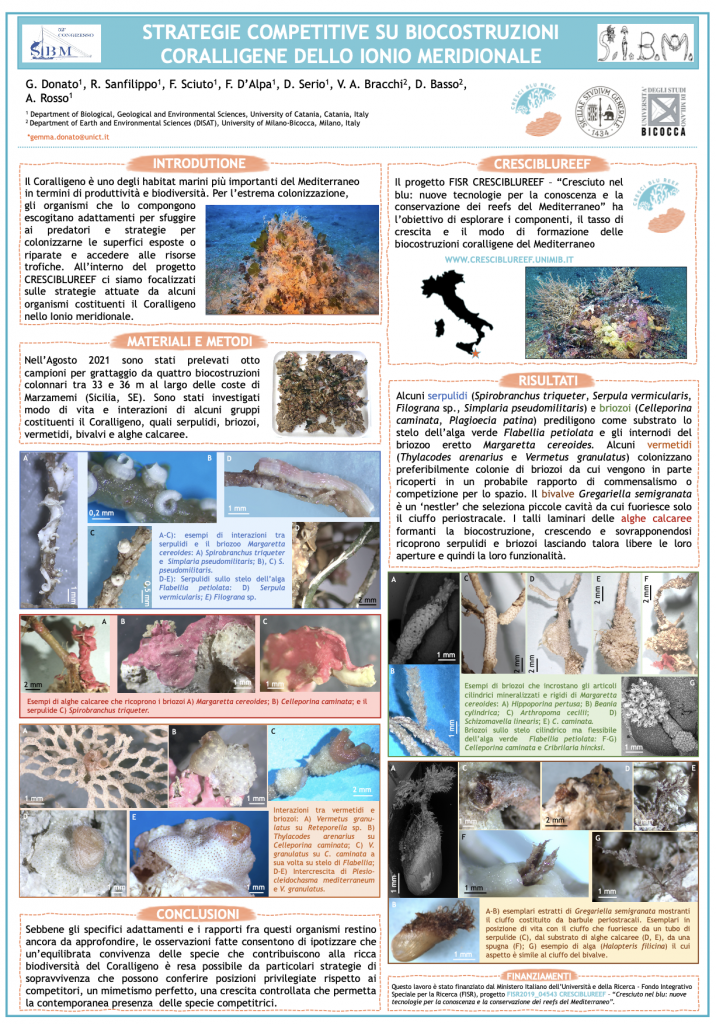
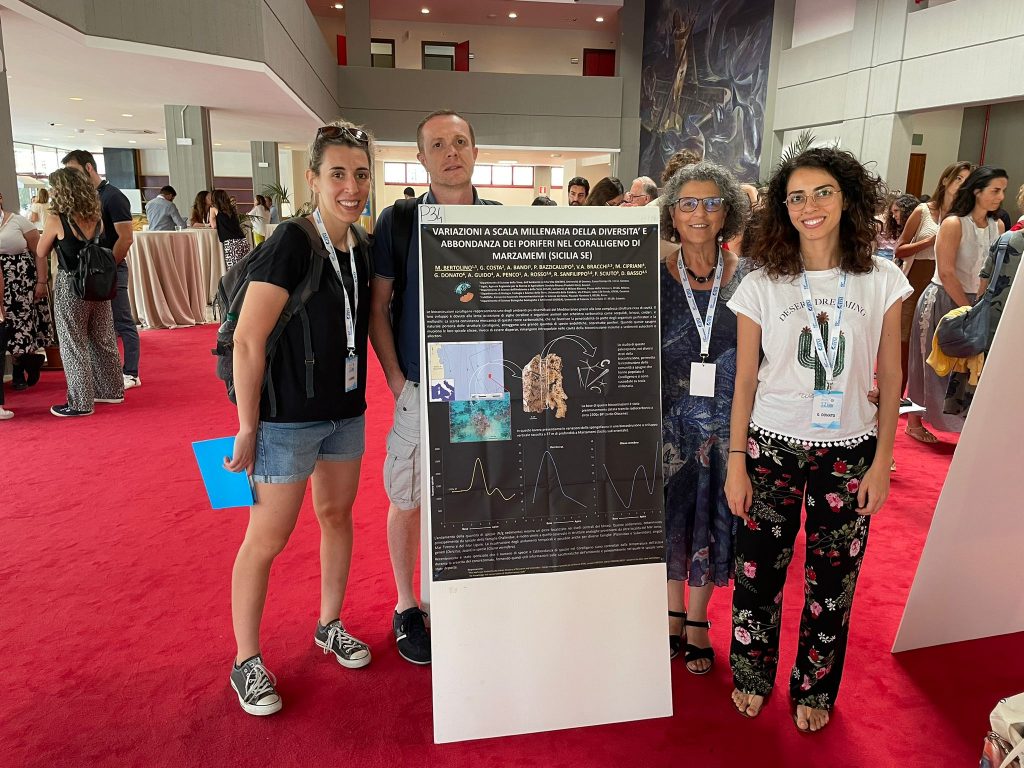


XXI INQUA 2023
ITALIAN BELOW:
ROMA _ 14-20 Luglio 2023
Dal 14 al 20 luglio si è svolto a Roma il 21° congresso INQUA (International Union for Quaternary Research).
Fieldtrip pre-congressuale
La Professoressa Basso, la dottoressa Bracchi e il dottor Bazzicaluppo hanno preso parte al fieldtrip pre-congressuale tenutosi alle Isole Egadi (Sicilia) denominato “Palaeogeographical evolution of the Egadi Islands (western Sicily, Italy): implications for late Pleistocene and early Holocene sea crossings by humans and other mammals”. Durante il fieldtrip, hanno visitato le tre isole maggiori dell’arcipelago e i numerosi siti geologici e archeologici presenti. Tra questi, con il direttore dell’AMP delle isole Egadi, il dottor Salvatore Livreri Console, ad esempio, la grotta del Tuono. Qui, la recente scoperta di Cervus elaphus e Patella caerulea come resti alimentari ha permesso di stimare che la navigazione del Mediterraneo risalga al Mesolitico. Oppure il Museo del mare di Marettimo, con il vicesindaco Vito Vaccaro, dove è stato possibile vedere le ossa dello stesso Cervus elaphus.
A Favignana hanno esplorato le antiche cave. Qui sono numerose le testimonianze di un passato in cui il paleoclima era più caldo dell’attuale con gli ospiti della fauna senegale come Tethystrombus latus (ex Strombus bubonius), e hanno osservato un tidal notch ben conservato con le relative perforazioni a opera di Lithophaga di età tirreniana. Infine, a Levanzo, hanno visitato la famosa grotta del Genovese. Un sito archeologico che conserva le tracce di vita dei nostri antenati di 13000 anni fa sotto forma di meravigliosi esempi di arte rupestre.
Congresso
Il congresso si è tenuto in una rovente Roma, tra il 14 e il 20 luglio 2023, e ha visto la partecipazione di migliaia di scienziati da tutto il mondo.
Il progetto CRESCIBLUREEF ha presentato le sue attività al proprio stand, dove è stato possibile raccontare ai presenti le attività svolte finora. Per qualche giorno è stato anche possibile osservar e il prototipo del carotiere montato sul ROV sviluppato dal gruppo di ingegneri dell’Università della Calabria. Tantissime persone si sono fermate attirate dal ROV e dai meravigliosi filmati che sono stati prodotti sul coralligeno di Marzamemi.
Sono state numerose inoltre le presentazioni orali e i poster. Inoltre, la professoressa Basso, è stata chair di una sessione che aveva come tema principale proprio le biocostruzioni atipiche come quella del coralligeno (Not only z-corals: Quaternary reefs across the latitudinal and depth gradients). Alla sessione hanno preso parte anche la Prof.sa Rossana Sanfilippo che ha parlato delle biocostruzioni del Mediterraneo, tra cui anche il coralligeno, la Dott.sa Gemma Donato ha esposto il ruolo dei serpulidi e briozoi nelle biocostruzioni del coralligeno e la stessa Professoressa Basso con una presentazione riguardo a un lavoro svolto a Lizard Island, Great Barrier Reef (Australia). Un’altra sessione è stata tenuta dalla Dott.sa Valentina A. Bracchi (Conservation paleobiology: late Neogene to Quaternary record sas a baseline for conservation of modern ecosystems) e anche qui sono stati presentati alcuni risultati relativi a CBR.
Ci vediamo alla prossima avventura!!
ENGLISH BELOW:
ROME _ 14-20 July 2023
The 21st INQUA (International Union for Quaternary Research) congress took place in Rome from 14 to 20 July.
Pre-congress fieldtrip
Professor Basso, Dr. Bracchi and Dr. Bazzicaluppo took part in the pre-congress fieldtrip held in the Egadi Islands (Sicily) called “Palaeogeographical evolution of the Egadi Islands (western Sicily, Italy): implications for late Pleistocene and early Holocene sea crossings by humans and other mammals”. During the fieldtrip, they have visited the three largest islands of the archipelago and the numerous geological and archaeological sites present. Among these, with the director of the AMP of the Egadi islands, Dr. Salvatore Livreri Consul, for example, the Tuono cave. There, the recent discovery of Cervus elaphus and Patella caerulea as food remains has allowed us to estimate that the navigation of the Mediterranean dates back to the Mesolithic. Or the Marettimo Sea Museum, with the deputy mayor Vito Vaccaro, where it was possible to see the bones of Cervus elaphus itself.
In Favignana they explored the ancient quarries. Here there are numerous testimonies of a past in which the paleoclimate was warmer than the current one with the hosts of the Senegalese fauna such as Tethystrombus latus (ex Strombus bubonius), and they observed a well-preserved tidal notch with the related perforations by Lithophaga of Tyrrhenian age. Finally, in Levanzo, they visited the famous Genovese cave. An archaeological site that preserves traces of the life of our ancestors from 13,000 years ago in the form of wonderful examples of rock art.
Congress
The congress was then held in a red-hot Rome, between 14 and 20 July 2023, and saw the participation of thousands of scientists from all over the world.
The CRESCIBLUREEF project presented its activities at its stand, where it was possible to tell those present about the activities carried out so far. For a few days it was also possible to observe the prototype of the core barrel mounted on the ROV developed by the group of engineers from the University of Calabria . Many people stopped attracted by the ROV and the wonderful films that were produced on the Marzamemi coral reef.
Also, there were numerous oral and poster presentations. Moreover, professor Basso was chair of a session whose main theme was precisely atypical bioconstructions such as that of coralligenous (Not only z-corals: Quaternary reefs across the latitudinal and depth gradients). During the session took part also Prof. Rossana Sanfilippo who spoke about the bioconstructions of the Mediterranean, including the coralligenous, Dr. Gemma Donato exposed the role of serpulids and bryozoans in the bioconstructions of the coralligenous and Professor Basso herself with a presentation on a work carried out at Lizard Island, Great Barrier Reef (Australia). Another session was held by Dr. Valentina A. Bracchi (Conservation paleobiology: late Neogene to Quaternary record sas a baseline for conservation of modern ecosystems) and also here some results related to CBR were presented.
See you on the next adventure!!

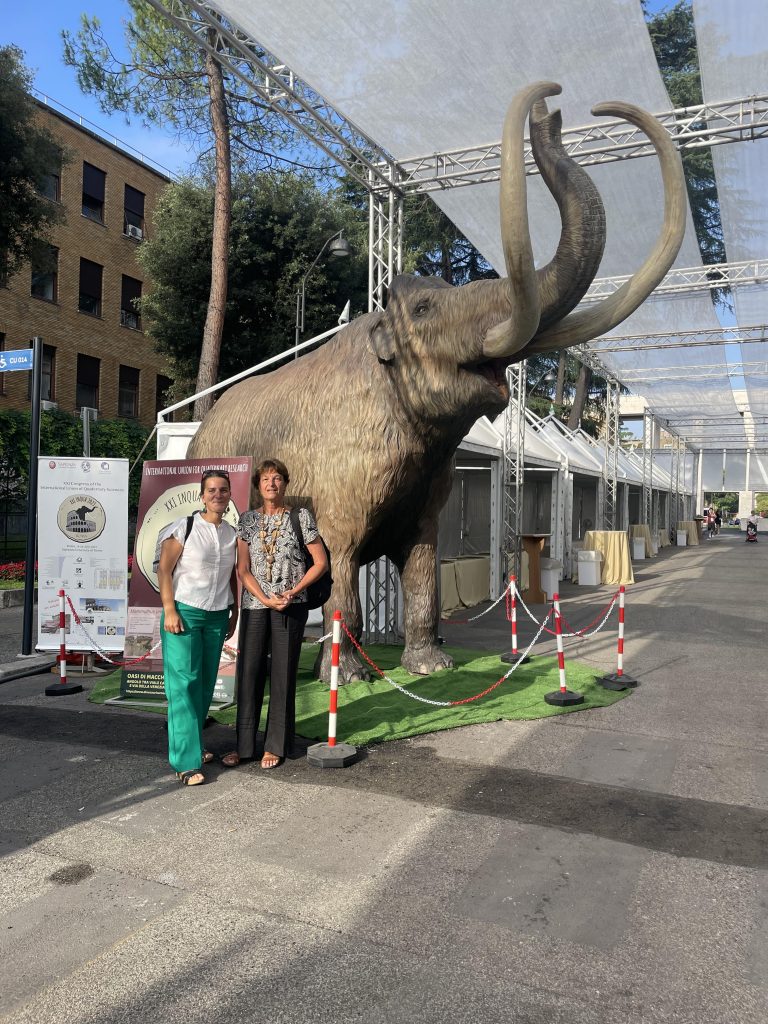
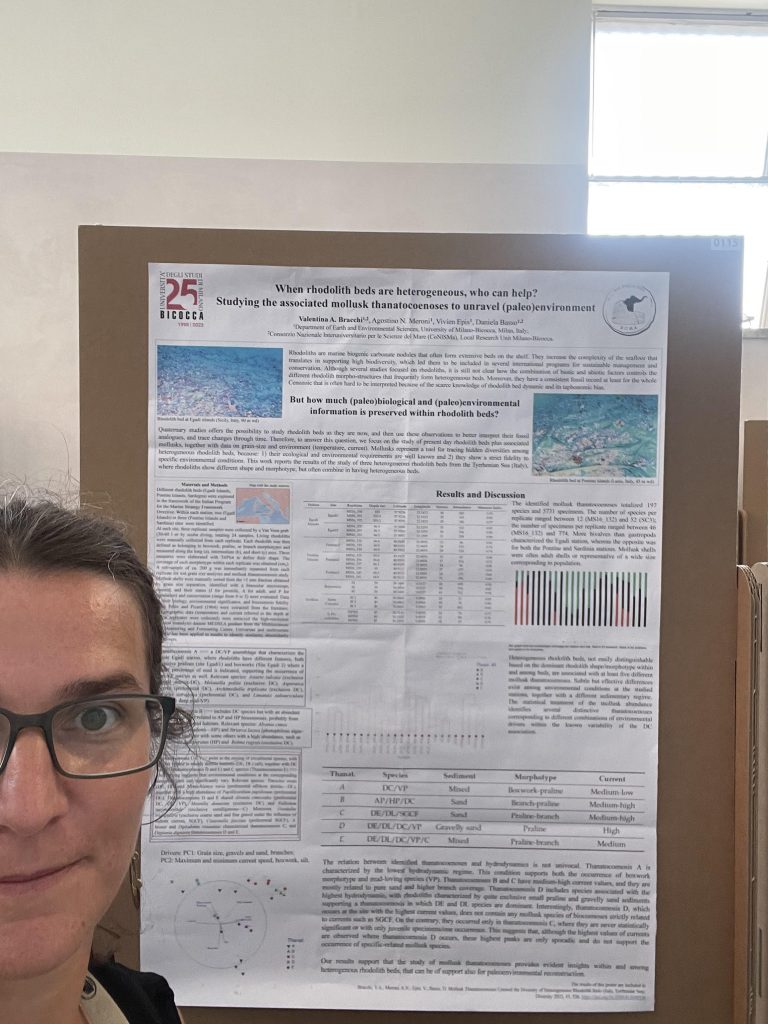
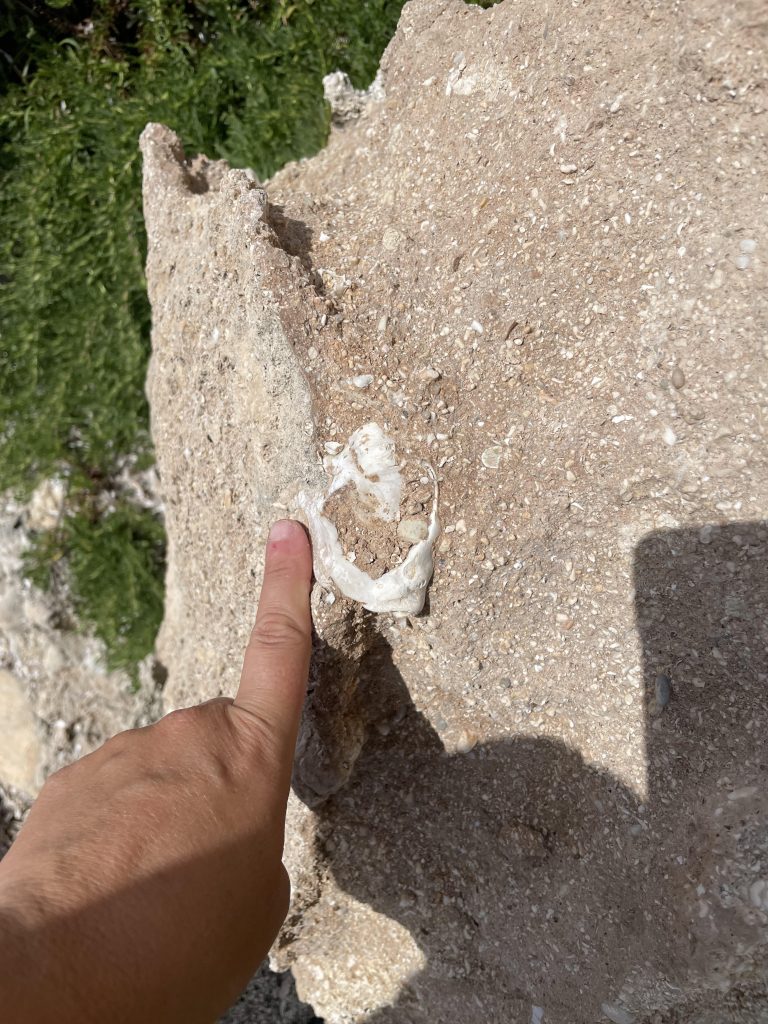


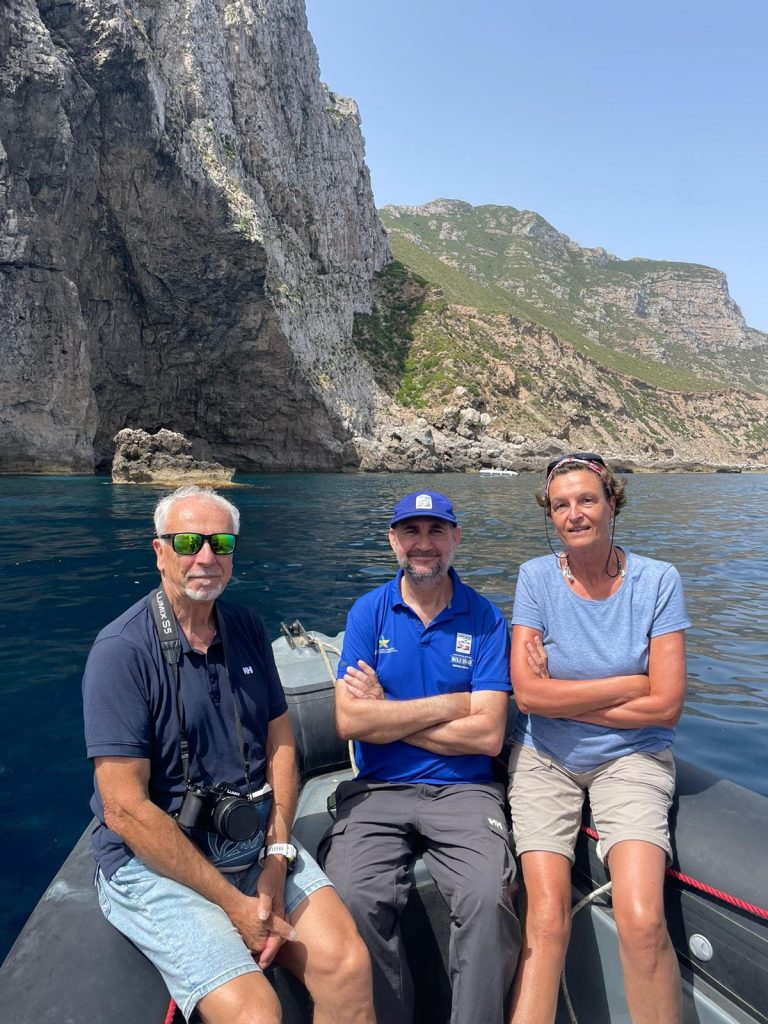

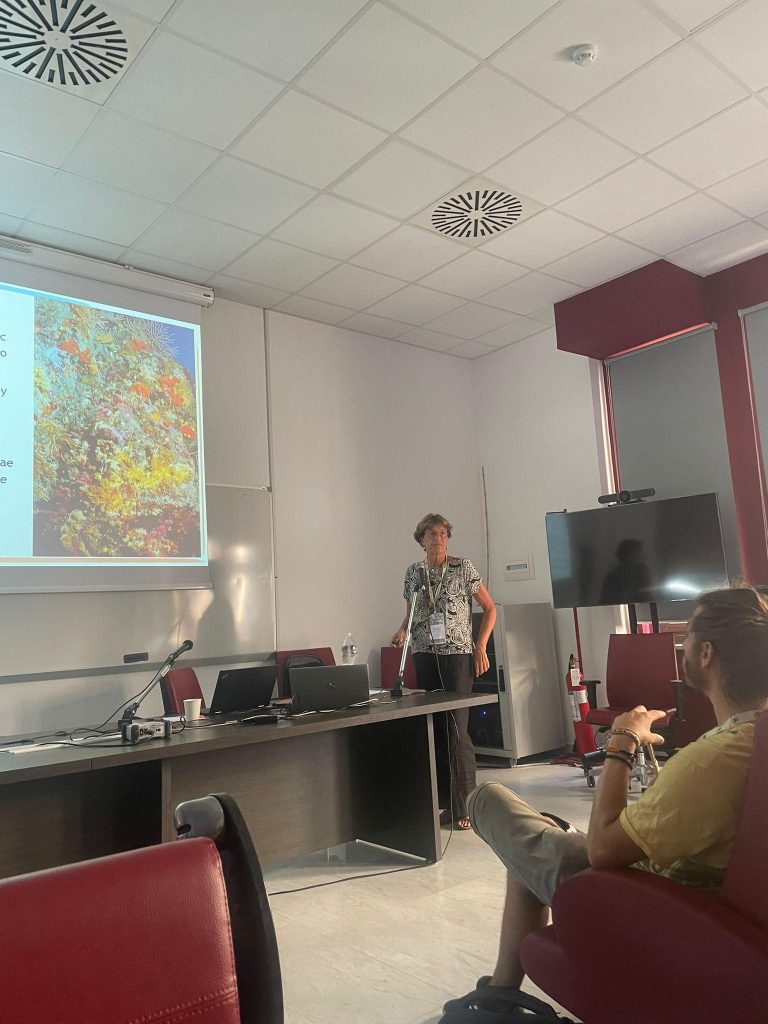

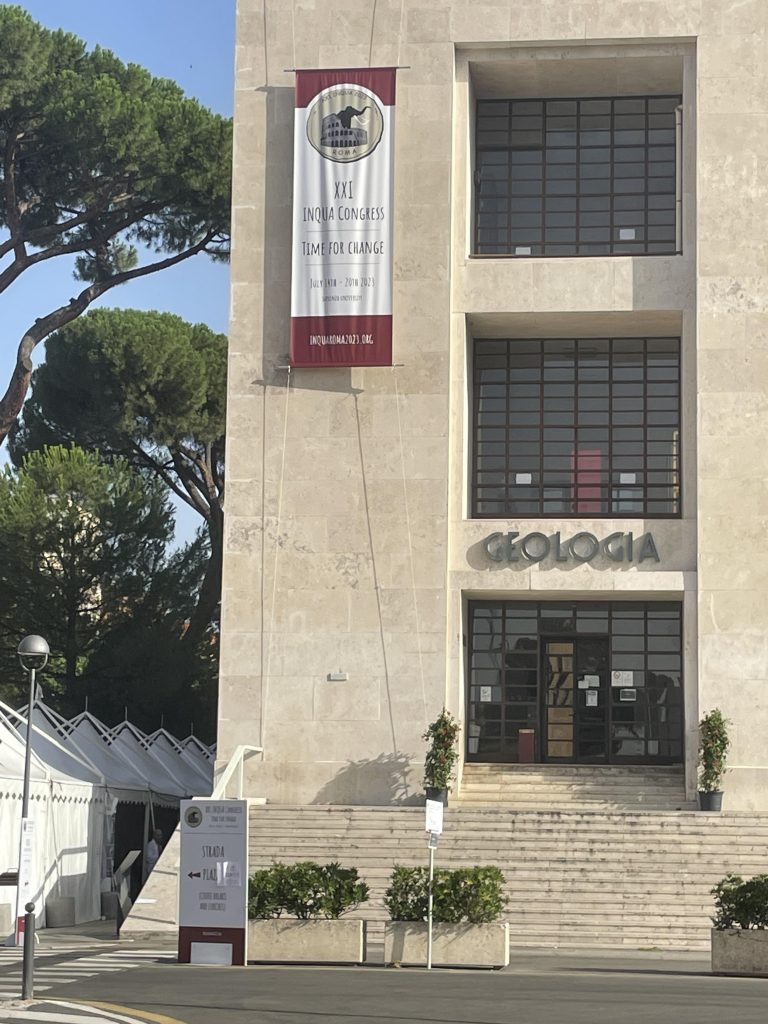
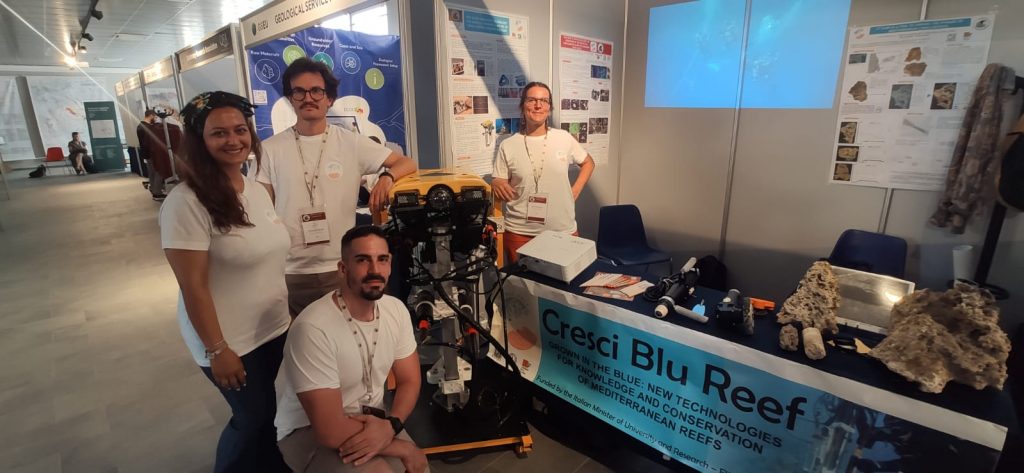

BEEE project (BioEngineering/Erosion Experiment)
ENG: The BioEngineering/Erosion Experiment wants to assess and quantify the processes of bioerosion and bioengineering taking place in a Coralligenous environment. The aim is to observe whether or not the substrate has a significance in the colonisation and bioerosion of the organism inhabiting the Coralligenous reef.
To do so we have deployed a series of experimental blocks of the same size but of different materials in the Marzamemi coralligenous area. The materials used are: Granite, Travertine and Marble.
The blocks will simulate the substrate where bioengineers and bioeroder will attach. Before the deployment we have scanned with a microCT machine the various blocks in order to have a baseline to compare them at the end of the experiment.
The blocks are anchored to the seafloor and will remain there for one year.
During this time SCUBA divers (of the SUTTAKKUA DIVING) are monitoring the state of colonisation.
Here are some pictures of the state of the experiment after 8 months.


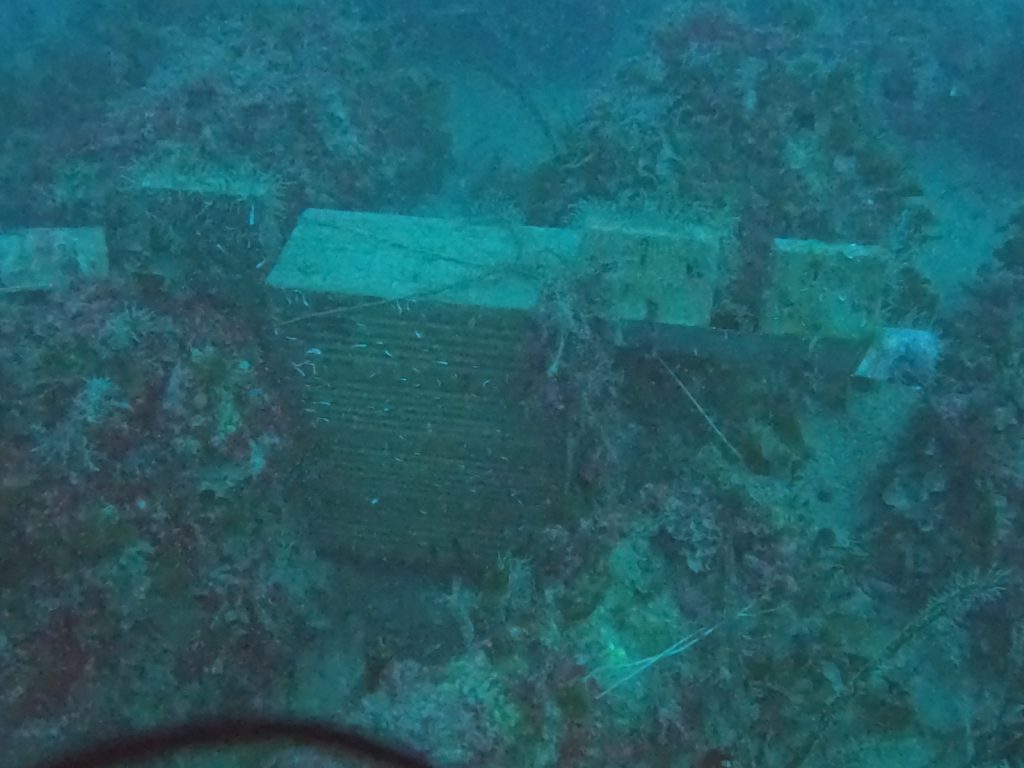
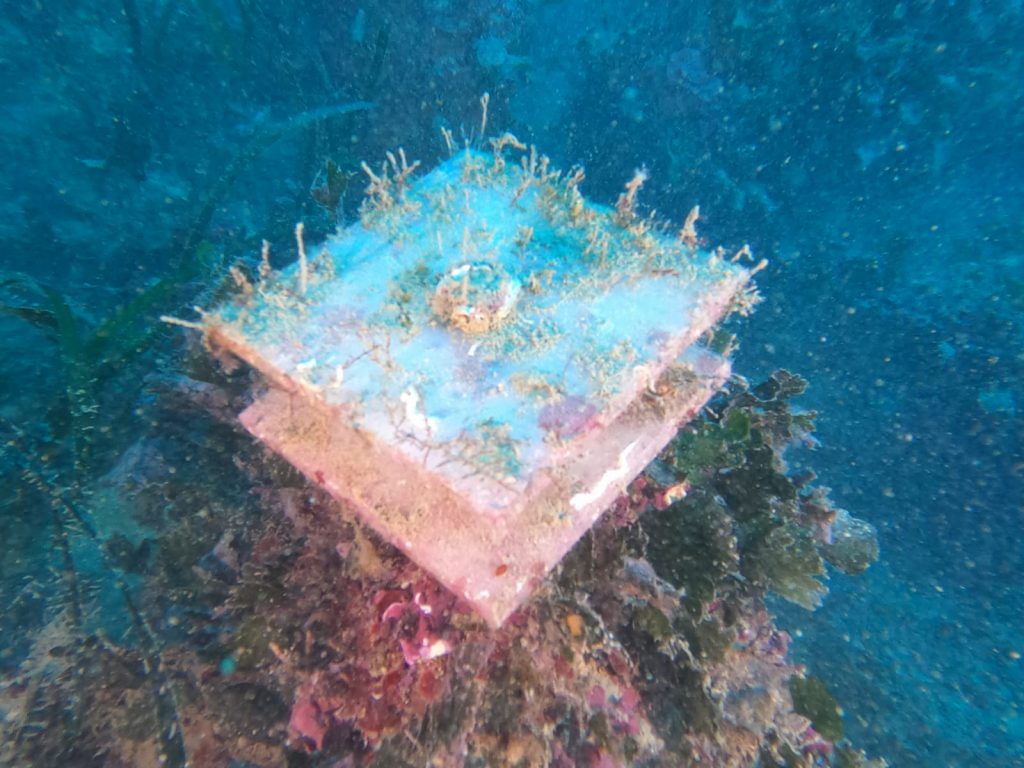
ITA: L’esperimento di Bioingegneria/erosione vuole valutare e quantificare i processi di bioerosione e bioingegneria che avvengono in un ambiente Coralligeno. L’obiettivo è quello di osservare se il substrato ha o meno un significato nella colonizzazione e nella bioerosione dell’organismo che abita la barriera corallina.
Per farlo abbiamo dispiegato una serie di blocchi sperimentali della stessa dimensione ma di materiali diversi nell’area del coralligeno di Marzamemi. I materiali utilizzati sono: Granito, Travertino e Marmo.
I blocchi simuleranno il substrato su cui si attaccheranno i bioingegneri e i bioeroder. Prima del posizionamento abbiamo scansionato con una macchina microCT i vari blocchi in modo da avere una linea di base per confrontarli alla fine dell’esperimento.
I blocchi sono ancorati al fondale marino e vi rimarranno per un anno.
In questo periodo i subacquei SCUBA (del SUTTAKKUA DIVING) stanno monitorando lo stato di colonizzazione.
Ecco alcune immagini dello stato dell’esperimento dopo 8 mesi.
XXI INQUA 2023
Rome __ 14-20 July 2023
ENG: From 14 to 20 July the INQUA (International Union for Quaternary Research) will be held in Rome. During this congress there will be a stand held by our team members in which they will present part of the work carried out by CresciBluReef. You will have the opportunity to see the ROV designed by the engineering team. In addition to the technological part, you will obviously find posters and materials on display regarding our research. There will be the possibility of interacting with some members present too.
ITA: Dal 14 al 20 Luglio p.v. si terrà a Roma l’INQUA (International Union for Quaternary Research). Durante questo congresso ci sarà uno stand tenuto dai membri del nostro team in cui presenteranno parte dei lavori portati avanti dal CresciBluReef. Avrete la possibilità di vedere il ROV progettato dal gruppo di ingegneria. Oltre alla parte tecnologica ovviamente troverete esposti poster e materiali che riguardano le nostre ricerche. Ci sarà anche la possibilità di interagire con alcuni membri presenti.
https://www.instagram.com/p/CuUg_D0NU91/?igshid=MzRlODBiNWFlZA==

SAMPLING CAMPAIGN CBR14
MARZAMEMI 27-28 Giungo 2023
ENG: The last sampling campaign took place in Marzamemi on 27 and 28 June. The activities carried out by the team coordinated by Prof. Adriano Guido were aimed at sampling the water columns on the verticals of the points where the CBR_2_3_7C and CBR_2_4_21C bioconstructions were taken during the previous campaigns.
The activities are part of the FISR CresciBluReef – Grown in the blue: new technologies for knowledge and conservation of Mediterranean reefs project, which involves three Italian universities: University of Milano-Bicocca, University of Calabria and University of Catania.
The researchers involved have different skills, ranging from geomicrobiology to water geochemistry. The sampling is aimed at the geochemical characterization of water at different depths from the surface and in direct contact with the bioconstructions. The aim is to identify possible geochemical proxies which are fractionated in the bioconstructions in equilibrium with the average composition of the water and which can be used as environmental tracers.
ITA: I giorni 27 e 28 giugno scorsi si è svolta l’ultima campagna di campionamento a Marzamemi. Le attività svolte dal team coordinato dal Prof. Adriano Guido sono state finalizzate al campionamento delle colonne d’acqua sulle verticali dei punti in cui sono state prelevate le biocostruzioni CBR_2_3_7C e CBR_2_4_21C durante le campagne precedenti.
Le attività fanno parte del profetto FISR CresciBluReef – Grown in the blue: new technologies for knowledge and conservation of Mediterranean reefs, che coinvolge tre università italiane: Università degli Studi di Milano-Bicocca, Università della Calabria e Università degli Studi di Catania.
I ricercatori coinvolti hanno competenze che vanno dalla geomicrobiologia alla geochimica delle acque e la campionatura è mirata alla caratterizzazione geochimica delle acque a diverse profondità dalla superficie e a diretto contatto con le biocostruzioni. Lo scopo è quello di individuare possibili proxy geochimici che vengono frazionati nelle biocostruzioni in equilibrio con la composizione media delle acque e che possono essere utilizzati come traccianti ambientali.
PALEODAYS 2023
Lecce (6) 7-9 June
ENG: Our Cresciblureef fellows Gemma Donato, Gianmarco and Francesco took part in PALEODAYS held in Lecce from 6 to 9 June. The congress had 115 participants from all over Italy and abroad, who presented 56 oral communications and 38 posters. To welcome the participants, the Organizing Committee has organised, for the afternoon of 6 June, a guided tour of the historic center of Lecce and a welcome aperitif (icebreaker party) at the Rectorate of the University of Salento. The pre-congress Round Table of the PaiP (Palaeontologist in Progress), dedicated to SPI unstructured young people and enthusiasts, was held at the MAUS.
The program included two days (June 7 and 9) dedicated to oral presentations and posters, with the space for posters set up at the MAUS; the social dinner was held on the 7th evening in the Rectorate. While the excursion took place on 8 June, with a visit to important paleontological sites in the Salento area: the complex of the Pietra Leccese quarries of Cursi-Melpignano; the Decio de Lorentiis Museum of Paleontology and Paletnology in Maglie; the former bauxite quarries of Otranto; the Oligocene calcarenites with carpets of rhodolites and macroforaminifera facies in the inlet of Porto Badisco; the Oligocene with corals of Calcare di Castro in the area of Grotta Zinzulusa.
The XXIII edition of the Paleontology Days took place at the Ecotekne University Campus and the Environment Museum of the University of Salento (MAUS).
.
.
ITA: I nostri borsisti Cresciblureef Gemma Donato, Gianmarco e Francesco hanno partecipato al PALEODAYS tenutosi a Lecce dal 6 al 9 giugno scorsi. Il congresso ha avuto 115 partecipanti da tutta Italia e dall’estero, che hanno presentato 56 comunicazioni orali e 38 poster. Per dare il benvenuto ai congressisti, il Comitato Organizzatore ha organizzato, per il pomeriggio del 6 giugno, una visita guidata del Centro Storico di Lecce e un aperitivo di benvenuto (icebreaker party) presso il Rettorato dell’Università del Salento. La Tavola Rotonda pre-congresso del PaiP (Palaeontologist in Progress), dedicata ai giovani non strutturati della SPI e agli appassionati, si è svolta al MAUS. Il programma ha previsto due giornate (7 e 9 giugno) dedicate alle presentazioni orali e ai poster, con lo spazio per i poster allestito presso il MAUS; la cena sociale si è svolta il 7 sera all’interno del Rettorato. Mentre l’8 giugno si è svolta l’escursione, con la visita ad importanti siti paleontologici del territorio salentino: il complesso delle cave di Pietra Leccese di Cursi-Melpignano; il Museo di Paleontologia e Paletnologia Decio de Lorentiis di Maglie; le ex-cave di bauxite di Otranto; le calcareniti oligoceniche con tappeti di rodoliti e facies a macroforaminiferi nell’insenatura di Porto Badisco; l’Oligocene a coralli del Calcare di Castro nella zona di Grotta Zinzulusa.
La XXIII edizione delle Giornate di Paleontologia si è svolta presso il Campus Universitario Ecotekne e il Museo dell’Ambiente dell’Università del Salento (MAUS).

The participants of the XXIII Paleontology Days (photo by S. Dominici)
European Geoscience Union
The European Geoscience Union or (EGU) is an interdisciplinary association open to all those who have a professional role in earth sciences, planetology, space sciences and related studies. The EGU aims to provide a forum for discussion between experts in all fields of geosciences.
Every year its General Assembly is held in Vienna which in 2023 took place from 23 to 28 April and saw the participation of 18831 scientists, from over 100 different countries.
During the Assembly, the work of the Cresci Blu Reef team was also presented, with the presence or virtual participation of numerous members of the project.
The works presented were the following:
Ecosystem engineers and biogeomorphology of the Mediterranean algal reef Coralligenous: Daniela Basso, Valentina Alice Bracchi, Pietro Bazzicalupo, Marco Bertolino, Fabio Bruno, Mara Cipriani, Gabriele Costa, Francesco D’Alpa, Gemma Donato, Luca Fallati, Adriano Guido, Maurizio Muzzupappa, Rossana Sanfilippo, Alessandra Savini, Francesco Sciuto, Andrea Giulia Varzi, and Antonietta Rosso
Ocean liming in eutrophic water: a mesocosm scale approach: Daniela Basso, Arianna Azzellino, Piero Macchi, Chiara Santinelli, Emilio Fernández, Pablo Serret, Giancarlo Bachi, Giovanni Checcucci, Alexandra Diaz, Eva Teira, Guido Raos, Silvia Valsecchi, Selene Varliero, Pietro Bazzicalupo, Karen Gariboldi, and Jose Gonzalez
Novel investigative techniques on calcareous red algae build-ups: photogrammetry and CT-scan on Coralligenous from Marzamemi (Sicily): Pietro Bazzicalupo, Valentina Alice Bracchi, Andrea Giulia Varzi, Luca Fallati, Alessandra Savini, Antonietta Rosso, Rossana Sanfilippo, Adriano Guido, Mara Cipriani, and Daniela Maria Basso
Underwater Scuba Photogrammetry VS. MBES Acoustic Sounding: how to integrate multiscale data for a better understanding of Coralligenous outcrops: Andrea Giulia Varzi, Luca Fallati, Alessandra Savini, Pietro Bazzicalupo, Valentina Alice Bracchi, and Daniela Basso
A pinnacle-like structure dominated by the chemosymbiotic bivalve Thyasira from the Arctic Sea: Marta Riva, Valentina Alice Bracchi, Claudio Argentino, Alessandra Savini, Luca Fallati, Giuliana Panieri, and Daniela Basso
Multi-specific calibration of the B isotope proxy in calcareous red algae for pH reconstruction: Giulia Piazza, Eduardo Paredes, Valentina Alice Bracchi, Leopoldo David Pena, Jason M. Hall-Spencer, Chiara Ferrara, Isabel Cacho, and Daniela Basso
The results of the works were presented and discussed within the huge and welcoming European geological community! Now the activities continue for the CresciBluReef team as it prepares for the summer samplings and other conferences. See you next year, again in Vienna, for the European Geoscience Union!
